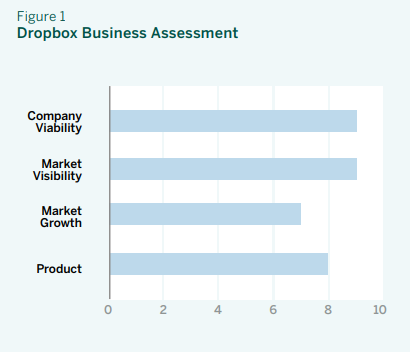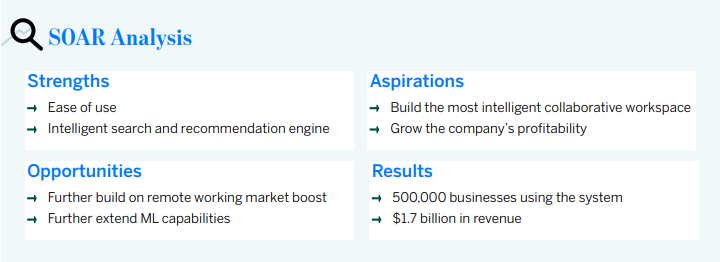Dropbox Business - Vignette by Deep Analysis
Founded 2007 | HQ San Francisco, CA | 2,000 employees (approx.) | $1.7B revenue (2019) Over the past five years, Dropbox has taken enterprise requirements much more seriously. The current incarnation of the Dropbox Business platform is smart, easy to use, scalable, and well worth considering for any large and diverse enterprise content/collaboration situation.

Dropbox, Inc was founded in 2007 by Drew Houston, the current CEO, and Arash Ferdowsi. The company is headquartered in San Francisco and has around 2,000 employees. It went public on the NASDAQ in 2018 and had revenues of $1.7 billion in 2019. Over the years, Dropbox has made more than 20 acquisitions, with the largest and most notable being digital signature company HelloSign for $230 million in 2019. This report focuses on Dropbox Business services.

The core of the Dropbox platform is in file storage and sharing; indeed, Dropbox is one of the predominant players in the EFSS marketplace. But although many still use it solely for EFSS, over the years the platform has evolved into a more comprehensive workplace collaboration system. Though this evolution has come through the addition of enterprise features, increasingly the transformation is driven by a focus on machine learning (ML) led by a team called DBXi (Dropbox Intelligence). To date, DBXi has been focused on building out proprietary ML capabilities, as opposed to relying on third-party tools from the likes of Amazon or Google, with a particular concentration on developing intelligent content recommendations and search. It’s important to note that Dropbox has built its own ML platform as a basis for multiple current and future intelligent platform features.
Considering how file-centric Dropbox is, it comes as no surprise that optical character recognition (OCR) is high on the list, and the firm has developed its OCR capabilities (AutoOCR) using a combination of traditional machine vision approaches with more advanced deep learning methods. This combined system provides OCR that can deal with regular documents and extract text from images and PDFs.
Dropbox has also built its own full-text search engine, called Nautilus. In our estimation, creating your own search engine is a risky undertaking. But considering the enormous amount of data that Dropbox collectively manages, contrasted with the highly particular requirements of individual Dropbox users, taking this route made sense. The challenge of personalizing and ranking the search experience through preferences, activities, and active document groups appears to have paid off. Nautilus bridges the gap between web search (massive scale) and traditional enterprise search (security, permissions, and personalization). Combined, the ability to read and index content at scale, alongside the ability to optimize the search experience, takes Dropbox closer to an active push versus pull approach to search. By this, we mean that the traditional activity of searching for items is balanced by the system’s automated ability to suggest and push relevant, contextualized content to users before they need to look for it. Worth noting is that Dropbox also utilizes ML to support image content searching, so, for example, a search on the word “truck” will return images of trucks.
As of today, ML has not been leveraged to automate workflows within Dropbox; rather, workflows are undertaken by third-party integrated applications. However, in our analysis the level of insight and control that the Dropbox ML platform provides suggests that automation of regular and repeatable work tasks should be a key part of Dropbox’s future development plans.
Consumer and enterprise security requirements differ considerably. For the former, one can apply layers of generic security and compliance; for the latter, much greater granularity is needed on top of this. Dropbox has the usual directory services integration, along with a single sign-on. But it goes further to provide security administration facilities such as broad access to audit logs, device, event, vulnerability, and incident management, and some data loss prevention (DLP) capabilities.

Also, Dropbox has added functionality to the platform for business and enterprise use; for example, the Insights Dashboard for team monitoring and management, Transfer to facilitate large file and folder movement, Rewind for rollback and backup capabilities, and Spaces for shared tasks and group notifications. Most notable, though, is that HelloSign, the digital signature product they acquired last year, is now integrated and accessible across the platform.
Ultimately, Dropbox is a Software as a Service (SaaS) application, so you get what you are given to some degree. That said, Dropbox is doing a good job of developing and delivering on all the base requirements for intelligent content and collaboration in a service that can be integrated via APIs plus an exceptionally large range of third-party applications.

Dropbox has always tried to differentiate itself through its claim that it designs for users. And to give the company credit, it seldom follows market trends; instead, it watches and learns from how users actually use the Dropbox system. As a result, the system is intuitive and very easy to use, and today serves over 600 million users (paid and unpaid) including 500,000 businesses, and manages over 550 billion pieces of content. That translates to big data on a big scale by anyone’s calculations. Such a huge volume of high-quality data is of course ideal for AI, but Dropbox has been cautious about leveraging it, in large part due to concerns over privacy and data protection. But the DBXi initiative seems to be steering the AI ship forward, and what we see today is useful and pragmatic but is surely only a fraction of what Dropbox could actually do in this field.
Figure 1 shows our assessment of Dropbox Business across four categories.

The foundations of Dropbox are in the world of consumer file sharing. Hence, product development was focused on meeting those needs rather than those of the enterprise. However, over the past five years, Dropbox has taken enterprise requirements much more seriously. The current incarnation of the Dropbox Business platform is smart, easy to use, scalable, and well worth considering for any large and diverse enterprise content/ collaboration situation.

About Deep Analysis
Deep Analysis is an advisory firm that helps organizations understand and address the challenges of innovative and disruptive technologies in the enterprise software marketplace. Its work is built on decades of experience in advising and consulting to global technology firms large and small, from IBM, Oracle, and HP to countless start-ups. Led by Alan Pelz-Sharpe, the firm focuses on Information Management and the business application of Cloud, Artificial Intelligence, and Blockchain. Deep Analysis recently published the book "Practical Artificial Intelligence: An Enterprise Playbook," co-authored by Alan and Kashyap Kompella, outlining strategies for organizations to avoid pitfalls and successfully deploy AI. Deep Analysis works with technology vendors to improve their understanding and provide actionable guidance on current and future market opportunities. Yet, unlike traditional analyst firms, Deep Analysis takes a buyercentric approach to its research and understands real-world buyer and market needs versus the “echo chamber” of the technology industry.

Alan Pelz-Sharpe
Alan Pelz-Sharpe is the founder of Deep Analysis. He has over 25 years of experience in the IT industry, working with a wide variety of end-user organizations like FedEx, The Mayo Clinic, and Allstate, and vendors ranging from Oracle and IBM to startups around the world. Alan was formerly a Partner at The Real Story Group, Consulting Director at Indian Services firm Wipro, Research Director at 451, and VP for North America at industry analyst firm Ovum. He is regularly quoted in the press, including the Wall Street Journal and The Guardian, and has appeared on the BBC, CNBC, and ABC as an expert guest.